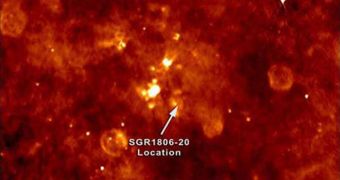In a new study of an old gamma-ray burst (GRB), astronomers determined that the cosmic event struck our planet with the energy equivalent of more than half a million years of continuous sunlight.
The event was so tremendously powerful that it caught us completely off-guard. Satellites in low-Earth orbit (LEO) and in geosynchronous orbits bore the blunt of the hit, while the upper atmosphere became very magnetized, and produced very bright auroras.
One of the reasons why this GRB was so powerful was because it originated relatively close-by, only some 50,000 light-years away. Scientists say that it came from the Sagittarius constellation.
It hit Earth on December 24, 2007, and lasted for no more than a few tenths of a second. In this interval, vast amounts of highly-energetic particles slammed into our planet. The rare magnetar SGR 1806-20 was the source of the radiation.
The astronomical designation SGR stands for soft gamma ray repeaters. These are neutron stars that are called magnetars, because they are surrounded by incredibly strong magnetic fields.
When these twisted magnetic fields attempt to re-align themselves on the surface of a magnetar, they break the stellar crust, allowing it to release a massive pulse of energy. This manifestation creates a large “dead zone” around the stellar object, which spans for several light-years in all directions.
But the 2004 GRB wasn't by far the only one to hit Earth full-on. Another one occurred on March 19, 2008, when GRB 080319B struck our planet at 2:13 am EDT (0613 GMT). Astronomers pinpointed its location in the constellation Bootes.
This was one of only a handful of GRB to be observed by the naked eye. It became intensely bright in the sky, experts explain, because it slammed matter directly into our planet at 99.99995 percent the speed of light.
NASA's Swift satellite was the first scientific instrument to detect the event. The Russian-built KONUS instrument on the NASA Wind satellite started its own observations immediately afterwards.
“Swift was designed to find unusual bursts. We really hit the jackpot with this one,” explains Swift principal investigator Neil Gehrels. The expert is based in Greenbelt, Maryland, at the NASA Goddard Space Flight Center (GSFC), Daily Galaxy reports.
Analyzing gamma-ray bursts – among the most violent events in the Universe – may hold the key towards understanding how massive stars die, and how neutron stars, magnetars and pulsars develop.

 14 DAY TRIAL //
14 DAY TRIAL //